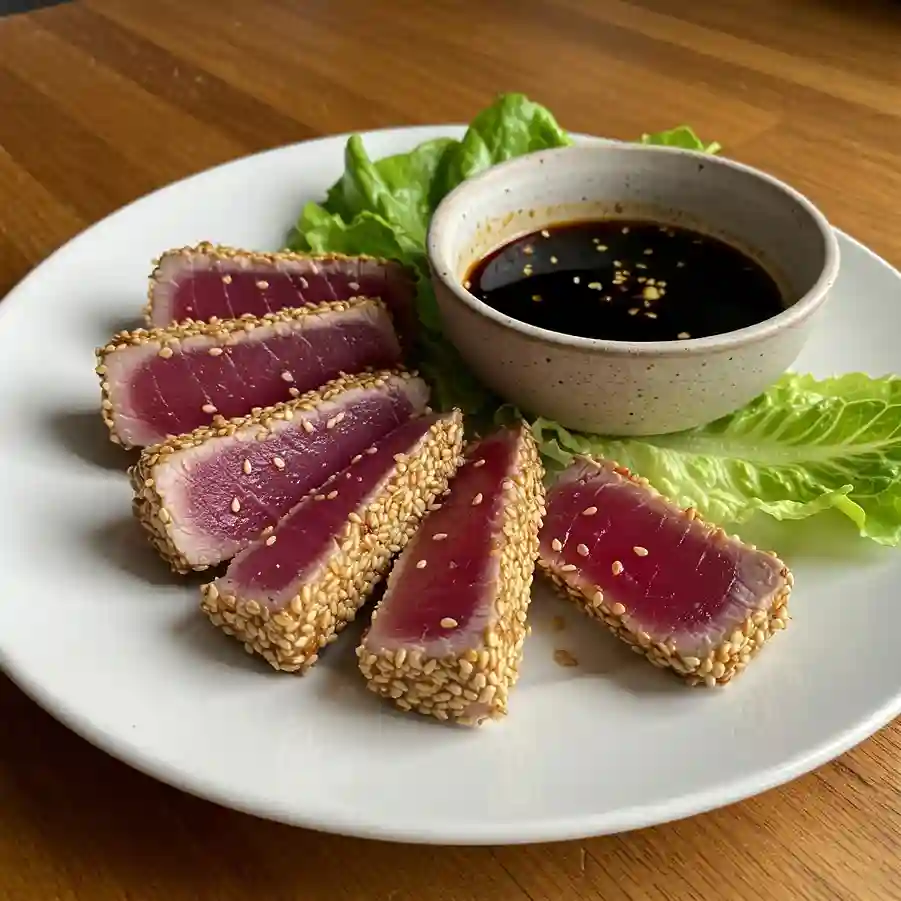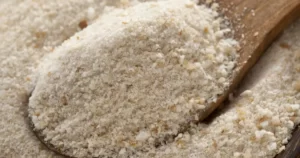I cook most things for myself, but this one’s for when family comes over.
Not a big crowd — just two or three of us around the table, catching up, passing the soy sauce back and forth, and going quiet every few bites because the food is actually that good.
Tuna like this doesn’t sit in the fridge for long. I buy it the same day I cook it. Usually from a shop I trust, sometimes after texting my brother to ask if he’s around for dinner.
Once it’s home, I don’t do much to it — just salt, pepper, sesame seeds, a quick sear, and that dipping sauce I always make in the same bowl.
I’ve made it enough times now that I don’t measure. But I still pay attention every time I cook it.
I like meals that feel a little different from the usual. Not “special occasion” different — just enough to pull me out of the routine.
A cold center, warm crust, soy and ginger cutting through the richness of the fish — that’s the kind of balance I keep coming back to.
And when the plate’s quiet at the end of the night, that’s how I know it landed.
Table of Contents
ToggleSesame-Crusted Tuna Steaks With Ginger-Soy Sauce Recipe
Ingredients (Serves 2)
For The Tuna
- 2 fresh tuna steaks (about 6 oz each, ideally sushi-grade)
- ½ tsp fine sea salt
- ¼ tsp ground white pepper (or black pepper if preferred)
- 1 tbsp light soy sauce
- 1 tsp toasted sesame oil
- ½ cup white sesame seeds (untoasted)
- 1 tbsp neutral oil for searing (grapeseed, sunflower, or avocado oil)
- A few leaves of romaine or butter lettuce (optional, for plating)
For The Ginger-Soy Dipping Sauce
- 3 tbsp light soy sauce
- 1 tbsp rice vinegar (unseasoned)
- 1½ tsp freshly grated ginger
- 1 tsp honey (or sugar, if you prefer a sharper finish)
- ½ tsp sesame oil
- ½ tsp crushed red pepper flakes (optional, adjust to taste)
- 1 tsp toasted sesame seeds (for garnish)
Instructions
- Pat tuna steaks dry with a paper towel. This ensures a good sear.
- Rub both sides evenly with the sea salt and white pepper.
- In a shallow dish, whisk together 1 tbsp soy sauce and 1 tsp sesame oil. Gently coat the tuna steaks in this marinade. Let sit for 5–7 minutes while you prep the crust and sauce.
- Pour sesame seeds into a flat dish or plate. Press each tuna steak firmly into the seeds, coating all sides. Press gently to help them stick well — no bald spots.
- Heat 1 tbsp neutral oil in a heavy nonstick or cast-iron skillet over medium-high heat. The pan should be hot but not smoking.
- Carefully lay the sesame-coated tuna into the pan. Sear each side for 30–40 seconds, including the edges. You’re aiming for a golden crust while keeping the center beautifully rare. Don’t overcook.
- Remove from pan and let rest for 1–2 minutes before slicing. Use a very sharp knife to slice into even pieces, about ¾-inch thick.
- For the dipping sauce, whisk all sauce ingredients together in a small bowl until smooth. Taste and adjust sweetness, saltiness, or heat as you like.
- To serve, arrange sliced tuna over lettuce leaves for a fresh touch. Serve with the ginger-soy sauce on the side and an extra sprinkle of sesame seeds if you like.

Tips For Making Sesame Crusted Tuna Steaks
A few small choices can make a big difference in how your tuna turns out. Here are some tips to help you get it just right:
- Use sushi-grade tuna: This isn’t about raw vs cooked — it’s about freshness and quality. Sushi-grade means it’s safe to eat rare or seared.
- Dry the tuna well before seasoning: Pat it dry with paper towels. Moisture makes it hard for sesame seeds to stick and stops the crust from crisping up.
- Season the tuna before coating: A little salt, pepper, soy sauce, or sesame oil adds flavor that goes beyond the crust.
- Press the sesame seeds in firmly: Don’t just roll it in the seeds — use your hands to gently press them in so they don’t fall off in the pan.
- Use a heavy pan and preheat it well: A hot pan gives you a fast sear without overcooking the inside. Cast iron or stainless steel works best.
- Don’t walk away while searing: Each side only needs about 30–40 seconds. Watch closely, flip carefully, and don’t overdo it.
Can I Eat Tuna Steak That Is Red In The Middle?
Yes, you can — and that’s how it’s usually served.
Tuna steaks are often seared on the outside and left red or pink in the center. This is safe as long as you’re using sushi-grade or sashimi-grade tuna from a trusted source.
The center should be cool or just slightly warm, while the outside gets a quick sear to develop flavor and texture.
If you’re pregnant, have a weakened immune system, or feel unsure, you can cook it longer — just know the texture will change and become more firm, almost like canned tuna.
What Types Of Tuna Should I Use For Searing?
Not all tuna is the same, and some types hold up better to searing than others.
- Yellowfin (Ahi): This is the most common choice for sesame-crusted tuna. It’s lean, mild in flavor, and holds its shape well when seared.
- Bluefin: Richer and more buttery than yellowfin. It’s more expensive but has a luxurious texture when served rare.
- Bigeye: A great middle ground — tender, flavorful, and often used in sashimi. Less oily than bluefin, more depth than yellowfin.
- Skipjack or albacore: These are usually used for canned tuna and aren’t ideal for this recipe. They’re softer and flakier, not good for searing.
How Do I Stop Sesame Seeds From Falling Off During Cooking?
To keep the sesame crust intact, you need the right prep and pan technique. Here’s what helps:
- Dry the tuna thoroughly first: Excess moisture makes it hard for seeds to grip the surface.
- Use a light coating of soy sauce or sesame oil: This gives the seeds something to stick to, without making the surface wet.
- Press, don’t just dip: Place the sesame seeds on a plate and press the tuna into them, one side at a time, using your hands to gently press and pack them in.
- Use a nonstick or well-seasoned pan: This stops the seeds from sticking to the pan instead of the tuna.
- Let the pan get hot before adding the tuna: If the oil and pan are hot enough, the sesame seeds will toast and stick quickly without falling off.
What To Serve With Sesame Crusted Tuna?
This dish goes well with fresh, clean sides. You don’t need anything heavy — just simple, balanced dishes.
- Steamed jasmine rice
- Chilled soba noodles
- Cucumber salad
- Edamame with sea salt
- Pickled ginger
- Shredded cabbage or slaw
- Roasted broccolini
- Avocado slices
- Ponzu or miso soup
- Lightly dressed greens
How To Store Leftover Tuna Steaks?
Tuna is best eaten fresh, but if you have leftovers, here’s how to keep them safe and still tasty.
- Cool it quickly: Let the tuna cool at room temperature for no more than 30 minutes, then move it to the fridge.
- Use an airtight container: This keeps it from drying out or picking up other smells in the fridge.
- Eat within 1–2 days: The texture will change, and the flavor won’t be as clean after that. It’s still safe for a short time, but not ideal.
- Don’t reheat it in a pan: That will overcook it. If you want to warm it up, let it sit at room temperature for 15–20 minutes or enjoy it cold, like leftovers from sushi.
- Freezing isn’t great: You can freeze seared tuna, but it will lose a lot of its texture and flavor. It’s better to eat it fresh or the next day.
Variations
If you want to switch things up while keeping the same base flavors, here are some great ways to change the recipe without losing what makes it special.
- Use black and white sesame seeds together: This adds a little more depth and color to the crust. It also gives a slightly nuttier taste.
- Add crushed coriander seeds to the crust: Mix a small amount with the sesame seeds for a light citrusy flavor that works well with tuna.
- Swap the dipping sauce with a citrus ponzu: Still soy-based, but with added tang from lemon or lime juice. It gives a fresher feel.
- Try a wasabi-soy drizzle: Add a bit of wasabi paste to soy sauce and thin it with water or rice vinegar. It adds heat without overwhelming the tuna.
- Serve with a ginger-scallion oil: A simple mix of chopped scallions, fresh ginger, and hot oil poured over — very aromatic and tasty with tuna.
- Marinate the tuna briefly in tamari or soy sauce: Just a few minutes before adding the crust gives it a deeper flavor inside.
- Crust the tuna in sesame and finely chopped pistachios: This adds a delicate crunch and a mild, slightly sweet taste that pairs well with seared fish.

How Do I Know When Tuna Is Cooked Just Right?
Tuna cooks quickly, and the goal is usually a warm, seared outside and a red or pink center. It should never be dry or fully gray in the middle unless you’re intentionally cooking it all the way through.
Here’s how to tell it’s done right:
- The outside should look golden and slightly crisp: The sesame seeds should be toasted but not burnt. It only takes about 30–40 seconds per side in a hot pan.
- The inside should still be cool or warm and red/pink: Cut into the center of the thickest part after cooking. The middle should not look fully cooked — that’s normal and safe with good quality tuna.
- The texture should be tender, not flaky: Fully cooked tuna becomes firm and crumbly, like canned tuna. A proper sear keeps the center soft and slightly chewy.
- Use your fingers to test: Gently press the side of the tuna steak — it should feel firm on the outside, but still springy in the center.
- Let it rest before slicing: Just a minute or two on the board helps the juices settle. Then slice across the grain to check doneness.
If you’re not sure, it’s better to undercook than overcook. Tuna can be eaten raw when it’s sushi-grade, so a rare center is not only safe — it’s the goal for this type of dish.
You May Also Like To Check Out These Recipes
- Oven Baked Sweet Potato Chips
- Viral Tiktok Cucumber Salad
- Funeral Potatoes With Hashbrowns
- Chinese Special Fried Rice Restaurant Style
- Authentic Spanish Seafood Paella
- Homemade Pretzel Crust Pizza
- Tomato Pasta
- Cheese Danish
- Baked Chicken Nuggets
- Spring Rolls
- Chicken Egg Rolls
- Creamy Cherry Tomato Pasta
- 5 Ingredient Orange Chicken
- Egg Roll In A Bowl
- Chicken Biryani
- Creamy Mushroom Pasta
- Cucumber Sandwiches
- Chicken Korma
- Grilled Fish Tacos With Cabbage Slaw
- Best Indian Mango Chicken Curry
- Authentic Thai Red Curry Shrimp
- Traditional Banh Mi











